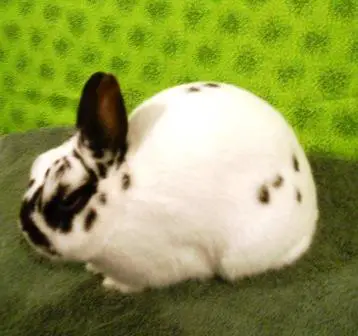Conditioning rabbits for show
Last Updated on July 20, 2022 by The Rabbit Smarties Team
How do you prepare a rabbit to do its best in a show?
Conditioning rabbits for show means a lot more than just giving them special foods. Housing, sanitation, selection, genetics, primary diet, and handling each have just as much to do with a rabbit’s success on the show table as extra food supplements, maybe more. So let’s cover some of those basics first:

A fresh, good quality pellet and clean water are really the most important things you can give bunnies. Many breeders have success on the show table feeding just pellets and water.
No supplements can beat a clean cage and the sanitary, well-ventilated environment that produces general health. Proper ventilation is essential to keeping healthy bunnies. A buildup of ammonia in the air will result in a suppressed immune system, making your rabbits vulnerable to snuffles and other illnesses. In the warm months, rabbits rely on moisture evaporating off their noses to keep cool, and good air flow helps this process. Empty trays often. Use a product like Sweet PDZ to keep the smell down.
Temperature and daylight also play a role in conditioning rabbits. A colder environment is better for fur condition than a warmer one. Although does produce best if they have 16+ hours of daylight in a day, show rabbits have better color quality if they receiving only about 8 hours of daylight. Light fades self colors such as black, blue, and chocolate most easily. One time I heard a judge talk about how his daughter got perfect chocolate color by keeping her rabbits in a closet. Of course then you have ventilation issues…
Cage size matters. Rabbits should have enough room to exercise for good flesh condition. Be careful not to overcrowd juniors; they grow into best condition if given individual cages by eight weeks.
Does feeding conditioners help at all?
Without the basic requirements of diet and environment, adding supplements to the rabbit’s feed won’t do much good. However, a lot of breeders add a little something extra in an attempt to get the best condition. There are lots of different “recipes” out there, but oatmeal, black oil sunflower seeds (the kind you feed birds), barley, and wheat germ are common ingredients. You can also buy commercial conditioners called “Showbloom” or “Doc’s Rabbit Enhancer” that work well for some people. A feed rep once told me that one of the reasons Showbloom is effective is that it encourages rabbits to drink more, and lots of water keeps them in good condition. So you can sometimes get the same effect by putting a tiny sprinkling of salt or a tiny bit of molasses on the feed.
But in every case, conditioners should be used with moderation, never fed in a quantity that would keep the rabbit from getting balanced nutrition through the pellets. Also, the younger your rabbits are the more dangerous it is to feed them high-energy conditioners. Young rabbits of course need lots of energy to grow, but it also has to be balanced with lots of fiber. Fiber is essential to keep a rabbit’s digestive tract running smoothly. Timothy hay is also a very good thing to feed bunnies because of its fiber content. This article at the National Jersey Wooly Club highlights the importance of fiber in a growing bunny’s diet.
Also, feeding high-energy conditioners puts your rabbit at risk of getting overweight, which isn’t healthy for the bunny or good for its show condition. You should always be able to feel the bumps of the vertebrae when you run a hand down the rabbit’s spine. You should be able to feel individual bumps, but they should be smooth and rounded. That indicates a healthy body weight. If you can’t feel the individual vertebrae, the rabbit is probably too fat.

Fur growth is connected to the rabbit’s metabolism. So if you need to get an adult rabbit to molt, feed a high-energy supplements such as calf manna. You can continue the supplements to bring it quickly into fur condition. Then once it is in condition, you want to cut out the supplements so it will hold that coat. If your rabbit seems to be “always molting,” you are probably feeding too much energy.
Forget Not the Details: Tattoos, Posing, and more!
There are a few other important things. One is keeping the cage clean. This is not only important for health purposes, but also to keep white rabbits from staining fur and feet. Use solid dividers between cages so rabbits cannot chew and spray each other. If you have stackers, make sure the drop pans fit properly so rabbits on the bottom cannot be stained by those above them. The tattoo is also important. Tattoo WELL ahead of the show, in case you get ink on the fur. Keep tattoos in good shape. All your conditioning efforts will be completely wasted if your rabbit gets DQ’ed for an illegible tattoo.
Handle your potential show bunnies. Train them to pose. A rabbit should be accustomed to sitting for the judge, so that it will pose as soon as a judge touches it. Some people also keep a talk radio running on low in the rabbitry to get the rabbits used to some background noise, so they won’t be as frightened at a show. As you can see, feeding conditioners is a relatively small part of turning bunnies into winners!
Above picture: Baxter, BOV Black 2009 Polish National Youth
Below picture: Rustic’s Forego, Broken Chocolate Polish rabbit with 25+ legs and multiple national wins including BOS in 2012.